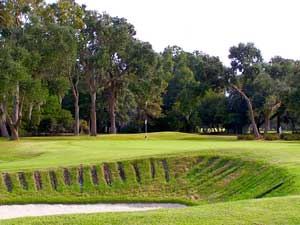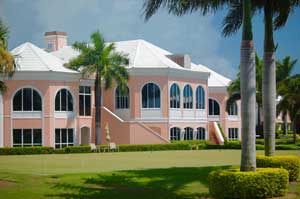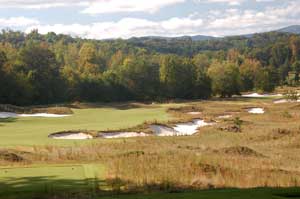Join Us for a Fall Discovery Weekend
at Carolina Colours, New Bern, NC
October 29 to November 1, 2015
For the time being, this is an exclusive offer to subscribers of Home On The Course. We intend to post this offer at GolfCommunityReviews.com and CarolinaLiving.com within the next 10 days if space remains
What if you could spend a weekend touring one of the Carolinas' most successful and smartly designed golf communities... play golf on an impeccably conditioned, fun layout... get answers to all your questions about searching for a golf community...enjoy a cocktail hour and then dinner with a group of residents you would be gratified to call your neighbors...and do all that at the discounted price of $350 for three days and two nights of fun, insights and a thorough understanding of what makes New Bern and Carolina Colours special? (Oh, did we forget to mention a boat ride as well?)
Announcing a Home On The Course & CarolinaLiving.com Discovery Weeked at the Carolina Colours community in coastal New Bern, NC, October 29 to November 1. The first 12 couples to sign up for this exclusive weekend and remit payment will enjoy the following:
- Waterfront hotel for two nights
- Boat cruise on the Neuse River
- Golf on Friday & Saturday
- Non-golfer activities include tour of Tryon Palace, the New Bern history museum, local arts & culture sites)
- Friday evening cocktail hour & buffet dinner with Carolina Colours residents
- Special Southern-cook-created lunch on Saturday
- Tour of Carolina Colours with a resident expert
- A look at specific properties and homes currently for sale (optional); opportunity to learn building process and prices from site contractors.
- Panel discussion: "How to Search for a Golf Community Home"*
* Panel includes: Ken Kirkman, Carolina Colours General Manager and veteran golf community developer (Landfall, Bald Head Island); Pat Mason, Co-Founder, Center for Carolina Living; and Larry Gavrich, Founder/Editor, Home On The Course.
Come discover New Bern and Carolina Colours, and have fun while you’re at it. For more information and to reserve your spot for this exclusive opportunity, contact Larry Gavrich, This email address is being protected from spambots. You need JavaScript enabled to view it..
10 Reasons to Consider
Carolina Colours
- Proximities. Carolina Colours is less than 12 minutes to downtown New Bern with its shops, restaurants, museums and historical sites. For those looking for an ocean fix, the beaches at Emerald Isle are a mere 50 minutes away; and those who long for a little hustle and bustle of city life can be in Wilmington or Raleigh in about two hours. And best of all, friends and family from the Northeast and middle-Atlantic regions can be at Carolina Colours for a visit after a leisurely one-day drive.
- Food for thought. Many retirees give up proximity to necessity shopping in exchange for lower real estate prices. Yet they never quite get used to having the nearest supermarket located a half hour from their home. Southern grocery chain Harris Teeter recently announced that it will open a supermarket just outside the entrance to Carolina Colours, and other conveniences are following. From the farthest reaches of the community, the trip to the shopping center will take about three minutes.
- New Bern. North Carolina’s second oldest city is loaded with history but squarely looking ahead. Bracketed by the Trent and Neuse Rivers, it is a major coastal center of leisure sailing. Home to an array of restaurants from upscale farm-to-table to small mom and pop cafes, visitors to New Bern are envious of those who live there, and with good reason. The famed Tryon Palace is just icing on the cake. Interesting side note: Pepsi Cola was invented in a New Bern pharmacy.
- Katherine Simms. Katherine runs the snack bar at Carolina Colours, and according to golfers and residents alike, she transforms ordinary snacks into what could almost pass for gourmet meals. I can vouch for her hamburger, one of the best I’ve had on or off the golf course. Katherine also caters the community’s Friday night buffet dinners where upwards of 75 of Carolina Colours’ residents get together and eat as well as they will all week, for just a few dollars each.
- Ken Kirkman. Ken is an environmental lawyer by training but, in practice, he is an impresario of golf community development, having superintended much of the development at Landfall in Wilmington, NC, and Bald Head Island, just off the North Carolina coast, before turning his attention to Carolina Colours. He is the most visible resident of all, as he and his wife Kathy chose to walk the talk by living in the community.
- Overlook Holdings LLC. Savvy management and long-time experience merged when Ken Kirkman invited Preston Development to take Carolina Colours to the next level. Not only does Preston bring the resources that ensure the community will remain debt free, but their experience with 25 other successful communities combined with Ken’s on-site presence provide Carolina Colours with organization expertise unrivalled by most other golf communties.
- The Golf Course. You could say a whole lot of Love went into the design of the Carolina Colours golf course. Noted architect Bill Love, a former President of the American Society of Golf Course Architects, thought long and hard about the types of golfers that would call the golf course theirs, and he fashioned a layout that is gentle to those who play the “gentlemen’s” and “ladies” tees but challenging to the low handicapper from the back tees. There is something for everyone among the pines and ponds of the Carolina Colours golf course.
- Bent grass greens. The greens at Carolina Colours deserve separate mention. If you play golf north of the Mason-Dixon line, chances are you putt on bent grass greens. If you haven’t putted on them, you don’t know what you are missing. But bent is notoriously tough to maintain during hot summers and, therefore, most southern golf courses use a form of Bermuda grass on their greens that are okay -- but they aren’t bent grass. Carolina Colours’ cool-headed superintendent has mastered the art of keeping his greens cool too.
- Real estate prices. Those who visit Carolina Colours for the first time and walk through a few of the developer homes, or the limited number of resale homes, are surprised at the prices --$200,000 and up for homes and $50,000 for lots. And homeowner and club fees are equally low.
- The Residents. Every golf community developer in America will tell you the people who chose their community are the friendliest anywhere. But until you actually meet them and ask them tough questions about life in the community, you won’t really know, will you? That is why when we host our Discovery Weekend at Carolina Colours in October (see above), it will include a Friday night dinner with residents. This will not be a staged event; residents of Carolina Colours get together every Friday night, and any couple considering a home in Carolina Colours should strive to visit at the beginning of any weekend and grab a chair in the clubhouse dining area.
A Special Offer for Home On The Course
Subscribers from Local Market Monitor
The specialized forecasts for housing in specific U.S. metor markets can be an invaluable resource to those of us preparing to spend hundreds of thousands of dollars on a home in the coming months and years. Ingo Winzer (see this month's main feature at right) is the principal of Local Market Monitor, which issues market reports that are an accurate, reliable source of home value and risk forecast data focused on specific housing markets. They help investors decide which market is the best investment opportunity, what is the overall risk of investing in a local market and how home values will change in the future. These Market Reports include a home price forecast, rent forecast, income-equivalent home value, local investment score and rating, local cap rates, and a written local market review.
Each report sells for $425, but Local Market Monitor has responded positively to my request for an extra incentive for Home On The Course readers. Between now and the end of August, LMM will provide a group of three reports for the price of one. The choice of the three markets is up to you. For example, if you are looking along the southeastern coast for a potential home, you might choose a bundle of reports that includes Wilmington, Myrtle Beach and Charleston; or, perhaps, Savannah, Charleston and Jacksonville, FL. If inland is where you might be headed, consider a package of Charlotte, Raleigh/Durham and Charlottesville. Or, perhaps, Greenville (SC), Asheville and Knoxville. If you are undecided where you might end up, mix and match between coast and inland. The choice is yours, and the cost is three for the price of one.
The future economic health of towns where you might choose to live could very well determine the value of your property five or ten years down the road. The $425 fee for an in-depth market analysis is a fraction of a percent of what you will pay for the cost of your next home and an investment worth considering.
To order your three reports or for more information, please contact Local Market Monitor Chief Operations Officer Carolyn Beggs at This email address is being protected from spambots. You need JavaScript enabled to view it..
If you would like more information on any golf communities, please contact me.
|
Playing Through: Noted Economist Writes
Now’s A Good Time To Look For A Golf Home
by Ingo Winzer
The last 10 years were a terrible time for Americans who were thinking about retirement.
First, back before the 2008 recession hit, anyone planning to buy a retirement property faced skyrocketing prices and a gut-wrenching choice. If you didn't buy immediately, you might never be able to afford that nice place near the shore or in the mountains. On the other hand, forking over such fistfuls of money would make a big dent in your savings.
Then came the recession and a flurry of body blows. The value of your home -- your biggest financial asset -- began falling. If you tried to sell, you found there were no buyers. And to cap off the carnage, the government decided to help out the big banks by pushing interest rates -- and your investment income -- close to zero.
No wonder anyone over 50 is angry (me too). The home-price bubble, the recession and bailouts for borrowers at the expense of savers all followed from government actions to help someone besides us.
Out of the wilderness
 The Myrtle Beach metro real estate market did not plummet as far as many others, and population growth in the area is well above the national average. DeBordIeu Colony in Georgetown, SC, is shown. The Myrtle Beach metro real estate market did not plummet as far as many others, and population growth in the area is well above the national average. DeBordIeu Colony in Georgetown, SC, is shown.
For years now, seniors could do little about this except sit home and sulk, or start ranting and join the Tea Party. But this wilderness period is over and finally the wheel of fortune has turned. Government hasn't become any smarter, but the famously invisible hand of the marketplace has come full circle to produce opportunities for buyers of retirement properties that didn't exist before.
Most importantly, it has ended the long slide in home prices. With some exceptions -- places where the local economy is still doing poorly -- the value of homes has gone up in the last couple of years.
As a bonus -- because vanished demand cut their prices so much -- retirement in many local markets is now a bargain. Where, and by how much, is what I'll discuss below.
Two additional points: Many seniors are able to take advantage of the current real estate opportunities because retirement portfolios have been repaired by shifting into better-yielding investments, riding the tails of a rising stock market. And the age demographics of the US population ensure that values in this sector of the housing market will rise faster than average home values for years to come.
Good math and an economic analysis
The underlying math is simple. Right now there are 33 million Americans aged 60 to 70 who are ready to retire in some way. Over the next decade, they will be followed by 44 million Americans who, today, are aged 50 to 60.
It's a simple question of supply and demand. Over the next decade, builders will not be able to put up retirement properties fast enough to satisfy the surge in demand; therefore, the value of a good retirement property bought in the next few years will go up and up.
Every property is unique, every golf and retirement community is different, and every investment in real estate has its own risks. You can always buy a turkey in a bull market. But you can reduce your risk if you buy in a local market that is more likely to attract other buyers in the future.
Two measures that gauge the attractiveness of local markets are population growth and job growth. A growing local economy is good for retirees. Sure, you can have a great retirement community in a place that isn't growing -- some people prefer that -- but most retirees want restaurants, shops and other services.
We'll look at local markets in several distinct retirement areas: the Florida Panhandle, the Florida Sunset Coast, the Florida East Coast, the Carolinas Coast, and Inland Carolinas.
Florida’s Panhandle
This area stretches from Gulf Shores in Alabama to around Mexico Beach, just east of Panama City, and is traditionally popular with retirees from the Midwest. Compared to other Florida areas, home prices here took much less of a hit after the recession; from peak to trough, prices fell between 30 and 40 percent. In the past year, prices rose in the single digits and we expect more of the same next year. Prices are still around 20 percent below where they should be; this is the bargain that's available right now.
The local economies are growing somewhat below average, but population growth in the last three years has been strong, especially in the Fort Walton Beach area. Home prices are around $240,000 in Fort Walton Beach, up 9 percent in the past year. Prices are lower towards Pensacola, $185,000, where the increase was 6 percent. The slowest local economy is Panama City, where prices were up just 3 percent.
Florida’s Sunset Coast
From Tampa at the northern end to Naples and Marco Island in the south, this stretch of Florida coast serves several retirement demographics. The further south you go, the more expensive homes get. The average price is $185,000 around Tampa Bay -- although closer to $140,000 near Lakeland – and $200,000 around Fort Myers, and $320,000 in Naples.
 Naples, FL real estate prices are growing Naples, FL real estate prices are growing
at twice the national rate.
Audubon Country Club clubhouse shown. Prices in this swath of Florida suffered severely in the downturn; on average, homes lost 50 percent of their peak value, but prices have recently been on the upswing -- up 8 percent in Tampa, 11 percent in Fort Myers, and 20 percent in Naples in just the past year. These very sharp increases overstate the actual value increase of the average home; they mainly reflect appreciation of foreclosed properties that had heavily depressed values to begin with, but they make the point that values are going higher rather than lower. We forecast a moderate rate of price increases in coming years.
The local economic picture supports a moderate increase in demand in the near future. Job growth is just average in Tampa-St. Pete, Lakeland, and the Bradenton-Sarasota area, somewhat above average in Fort Myers and Naples. Tampa-St. Pete is the important market in this region, bigger than all the others put together. Population growth in Tampa over the last three years was close to the U.S. average, about 1 percent per year. This suggests a recovering market but by no means an overheated one. Fort Myers and Naples, on the other hand, have been growing at twice the national rate. Home prices in Tampa are pretty much where they should be, and you won't find many bargains.
Florida’s East Coast
From Daytona Beach to Miami Beach, and including Ocala inland, this area comprises the largest stretch of retirement communities in the U.S. As on the Sunset Coast, home prices are lower in the north, higher in the south, and with a detour halfway down at Palm Beach.
Ocala presents the most affordable homes in the region, at around $140,000. From Daytona Beach to Fort Pierce, prices are in the $160,000 to $180,000 range. And from West Palm Beach down to Miami, average prices are above $250,000.
Partly because of the easy accessibility from the Northeast, many retirement properties here start off as winter vacation homes or investment properties. The possibilities for investment speculation produced a boom in prices before the recession, and a huge bust afterwards, with a drop in prices from peak to trough of 50 percent and more. Worst hit were the smaller markets like Port St. Lucie and Vero Beach where speculative overbuilding was the strongest.
Home prices are now again on the rise, but -- as on the Sunset Coast -- recent large price increases are misleading because they mainly are from foreclosed properties. That said, the average price increase in the past year was 10 percent, a bit less in Ocala. We expect moderate price increases in these markets over the next three years.
Despite recent price increases, bargains remain from Daytona Beach down to Fort Pierce -- and especially in Ocala -- but there are very few in the more southern markets.
Population growth in most of these markets is slightly above the national average. Job growth is very close to the national average in all of these markets, although Vero Beach lags a bit. Overall, this represents steady growth that will produce steady home price increases rather than speculative investment returns.
Carolinas Coast
These communities run from Wilmington in North Carolina down to Brunswick in Georgia. With the exception of the cities -- Wilmington, Charleston, Savannah -- the lack of other economic opportunities along the coasts has allowed widespread development of vacation and retirement communities.
Average home prices range from $150,000 in Brunswick and Myrtle Beach to $270,000 in Hilton Head and Charleston. These communities were less affected by speculative investment than those in Florida; peak home value losses along the coast after the recession were around 25 percent. Price increases in the last year were around 4 percent -- a bit higher in Charleston, a bit lower in Hilton Head and flat in Brunswick.
There are still bargains to be had around Savannah and Wilmington. The weak prices in Brunswick suggest there are bargains to be found there too, but the slow population growth -- well below the national average -- means second and third looks are in order.
Job growth is close to the national average in these markets, but we don't have data for Brunswick or Hilton Head. With the exception of Brunswick, population growth is well above the national average, especially in Hilton Head and Myrtle Beach.
Inland Carolinas
These communities include Raleigh, Charlotte and Asheville in North Carolina; Greenville in South Carolina; Charlottesville in Virginia; and Knoxville in Tennessee. Because they are part of larger urban areas, they present different attractions than the Florida markets. They generally are economically more stable and more oriented towards golf.
 Golf communities like the Cliffs at Mountain Park (shown) depend on the economic health of nearby cities, like Greenville, SC, in this case Golf communities like the Cliffs at Mountain Park (shown) depend on the economic health of nearby cities, like Greenville, SC, in this case
We can't separate the retirement communities from their urban areas when we measure home prices, jobs and population, but this isn't such a big problem because their popularity depends partly on the vibrancy of the surrounding economy. People like retiring here because the big cities are close by.
Average home prices are much the same in all these markets, close to $200,000, but higher in Charlottesville at $270,000. The peak-to-trough loss in home values after the recession was modest, from 10 to 15 percent. There are therefore fewer bargains to be found, with the best possibilities around Raleigh and Greenville. Home prices in all these markets were up around 5 percent in the past year. We expect 5 percent increases for the next few years.
The local economies have grown at remarkably similar rates in the past year, very close to the national average. The main way you can separate these markets is by their population growth. For Asheville and Greenville, that growth has been average; for Knoxville and Charlottesville, it has been below average; and for Raleigh and Charlotte, it has been about twice the national average.
Tale of two cities for fast growth
One of the fastest-growing markets in the country is Raleigh, NC. Its population in the last three years increased 6.9 percent (more than double the national average), and job growth in the last 12 months was 3.5 percent (compared to the 2.2 percent national average). Myrtle Beach is a much smaller market (and therefore more volatile), but the corresponding stats are 8.3 percent and 3.5 percent.
Where you retire depends on what you want -- mountains, rivers, lakes, the seashore. Many people want sun but some also want a change of seasons. Some people can afford more home than others. The good news, now and in the near future, is that the prices of retirement properties are again affordable, that they've stopped going down, and that they'll increase at a steady pace in most local markets throughout the next decade. Despite reports of sharply higher prices in Naples, for example, you don't have to rush out before it's too late. There's no particular hurry, take your time -- but now IS a great time to start looking.
Ingo Winzer
President
Local Market Monitor
Cary NC
Ingo Winzer is Founder and President of Local Market Monitor, and has analyzed real estate markets for more than 20 years. His views on real estate markets are often quoted in the national press and, in 2005, he warned that many housing markets were dangerously over-priced. Previously, Ingo was a founder and Executive Vice President of First Research, an industry research company that was acquired by Dun and Bradstreet in March 2007. He is a graduate of MIT and holds an MBA in Finance from Boston University. He resides in Cambridge, Massachusetts.
Larry Gavrich, Founder & Editor
GolfCommunityReviews.com
|


